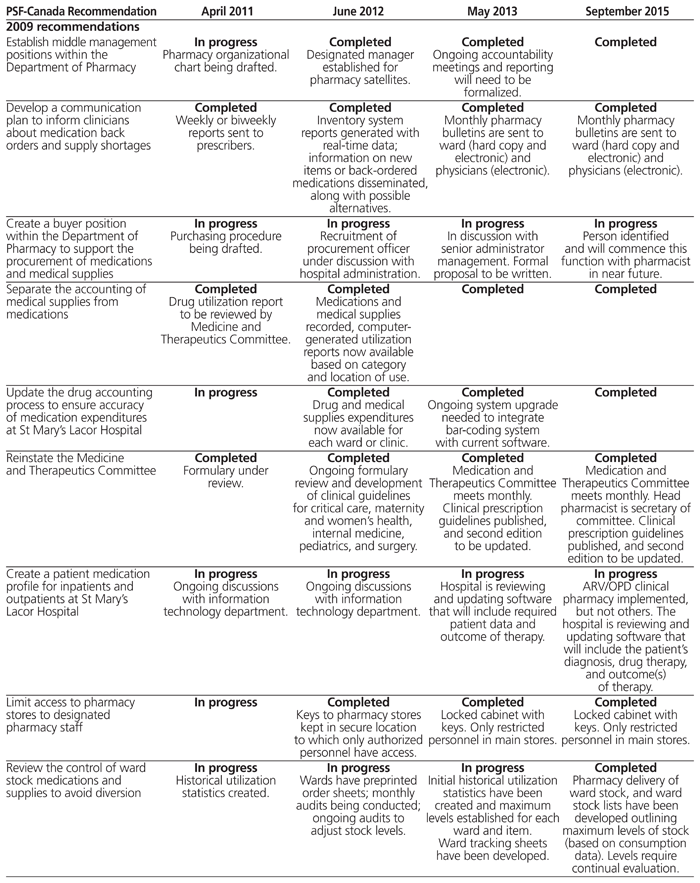
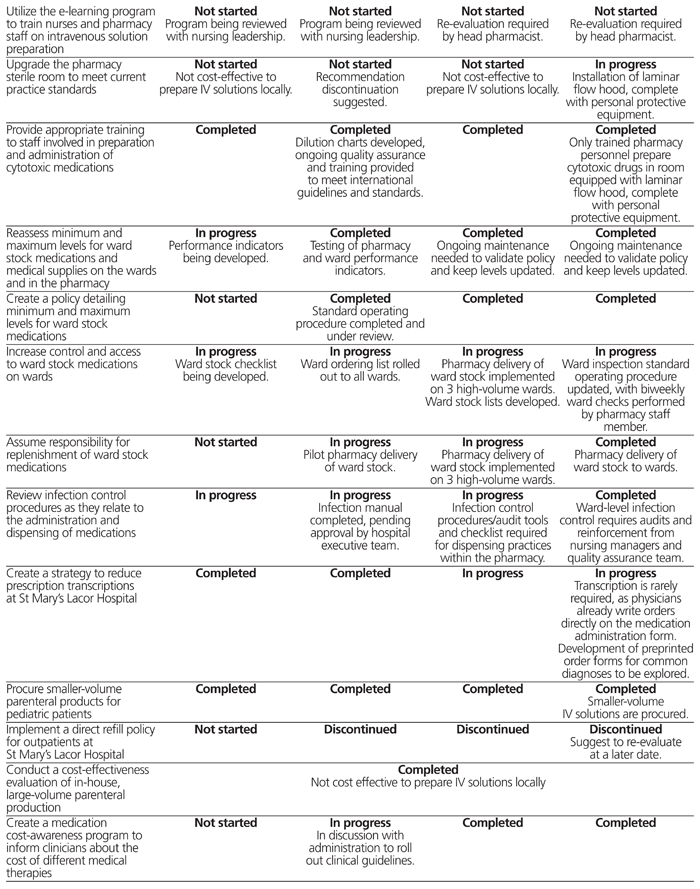
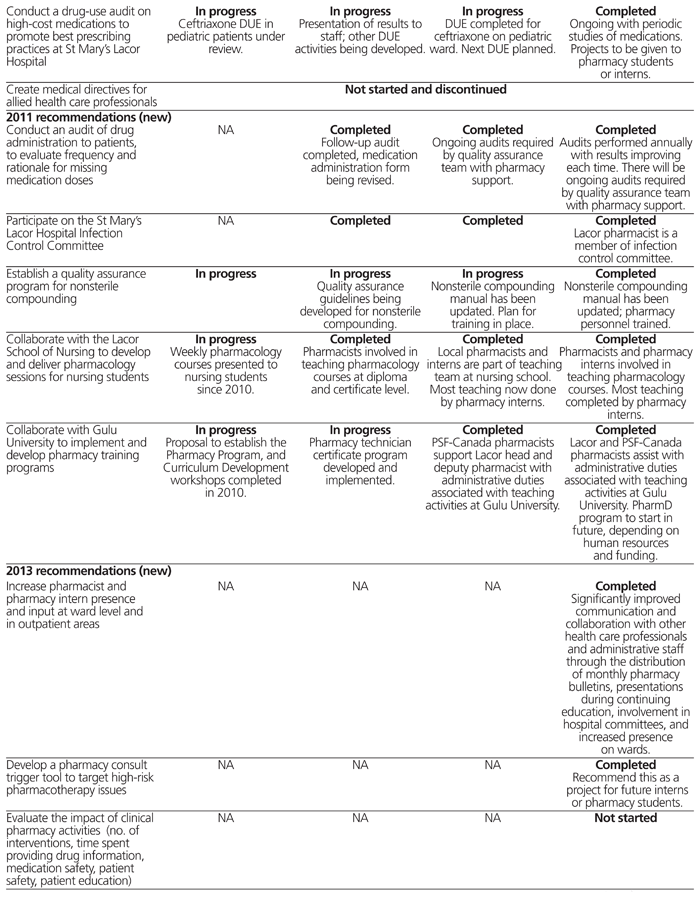

Danielle Stacey, Régis Vaillancourt, Lisa Brander, Nathalie Chenel, Elizabeth McMahon, Jennifer Wiebe, Allison Kirkwood, Ghada Shaka, Doret Cheng
St Mary’s Lacor Hospital (Lacor Hospital), located in the Gulu District of Northern Uganda, was founded in 1959 by a group of Comboni missionaries and was later developed and expanded by a Canadian surgeon, Dr Lucille Teasdale, and an Italian pediatrician, Dr Piero Corti.1 The hospital grew from a 30-bed hospital to a 483-bed health care centre, providing care to about 500 inpatients and 800 outpatients daily. Lacor Hospital also supports and operates 3 peripheral 24-bed health centres, each about 10 km from the hospital, to serve the villages surrounding Pabbo, Opit, and Amuru. The hospital has become a training ground for various health care professionals, including students from the faculties of medicine and pharmacy and the midwifery programs of Gulu University, Makerere University, and Mbarara University. In addition, the Lacor School of Nursing and Lacor School of Laboratory Technology were developed within the hospital. In 2009, the hospital’s executive team identified the need for the Department of Pharmacy to establish optimal strategies for logistical support and technical assistance with regard to medication management and pharmacy practice.
The challenges highlighted at Lacor Hospital parallel the vision of the World Health Organization (WHO) and the International Pharmaceutical Federation (FIP) of optimizing patient safety, utilizing health care resources responsibly, and ensuring the integrity of the medication supply chain.2 In 2009, Pharmaciens sans frontières (also known as Pharmacists Without Borders—Canada or PSF-Canada) was contracted by the Teasdale-Corti Foundation and the Lacor Hospital executive team to provide pharmacy support, knowledge exchange, and technical assistance to the Lacor Hospital Department of Pharmacy.1 Two PSF-Canada pharmacists (including R.V.) conducted the initial on-site evaluation, which resulted in 24 recommendations aligned with the FIP’s 2008 Basel Statements on the future of hospital pharmacy (Table 1). The recommendations presented by PSF-Canada served as an action plan for interventions and a guiding document for the PSF-Canada pharmacists and the Lacor Hospital pharmacy management team to achieve the vision of the 2008 Basel Statements for hospital pharmacy practice.
Table 1 Status of PSF-Canada Recommendations (2011–2015)



The 2008 Basel Statements consisted of 75 consensus statements reflecting a shared vision of the future practice of hospital pharmacy.3 The statements were developed in 2008 by an international consortium of 348 pharmacists, from 98 countries, at the 68th Congress of the FIP. The consensus statements were grouped under 7 themes addressing all areas of hospital pharmacy practice: overarching statements on the future of hospital pharmacy, medication procurement, influences on prescribing, preparation and delivery of medications, administration of medications, monitoring of medications, and human resources and training. The Basel Statements strive for a measure of agreement about the vision of hospital pharmacy practice across borders and across cultures. They have been used to assess or advance hospital pharmacy practice in many areas of the world, including China, Europe, the United States, Canada, Uruguay, the Western Pacific Region, and now Uganda.4–12
In May 2010, PSF-Canada deployed its first Canadian pharmacist (G.S.) to put the action plan into motion. Poh and others1 published the first part of this illustrative case study, which described the process of utilizing the 2008 Basel Statements in assessing, realigning, and monitoring pharmacy practice at Lacor Hospital from 2010 to 2012.1 Collaboration between PSF-Canada and Lacor Hospital has been ongoing from 2009 to October 2015. The aim of the current article is to illustrate and highlight the actions taken and accomplishments achieved over a 5-year period, utilizing the 2008 Basel Statements to assess, realign, and monitor pharmacy practice.
In 2009, 2 PSF-Canada pharmacist advisors (including R.V.) conducted an initial needs-based assessment. An original action plan was developed by PSF-Canada, in conjunction with the Lacor Hospital executive and pharmacy managers, consisting of 24 recommendations (Table 1). The aim of the action plan was to address and close the gaps between current and desired hospital pharmacy practice as envisioned by the 2008 Basel Statements (Table 2).
Table 2 Assessment of Pharmacy Practice St Mary’s Lacor Hospital in Relation to 2008 Basel Consensus Statements*†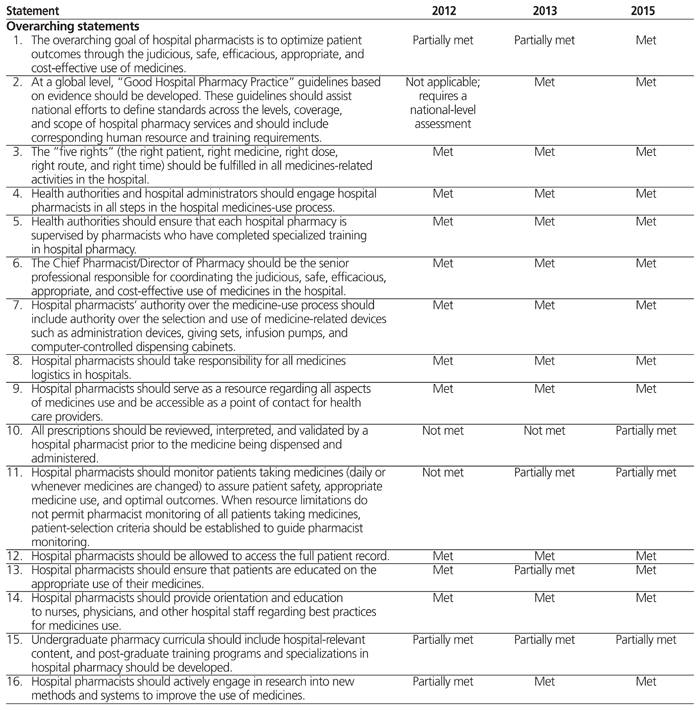
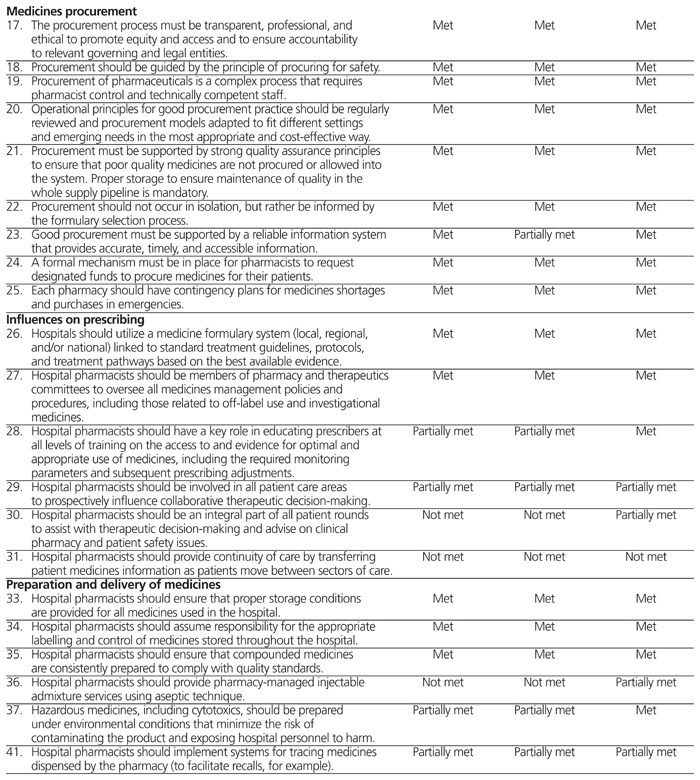
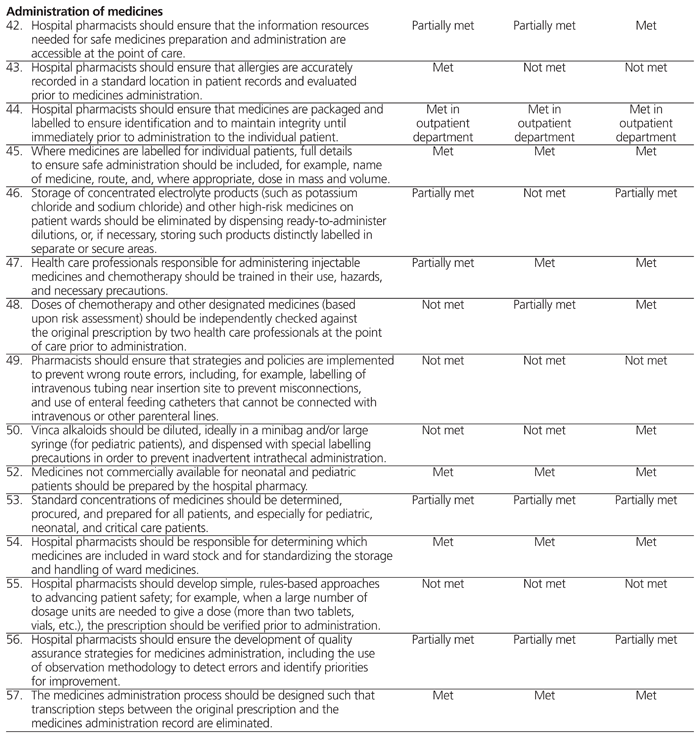
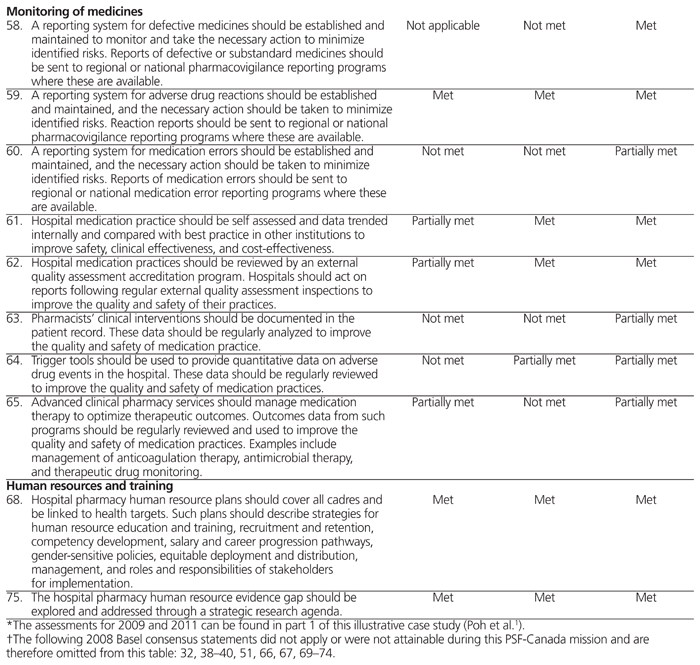
The first PSF-Canada pharmacist began working at Lacor Hospital in May 2010. In total, the mission consisted of 9 deployments of Canadian pharmacists over the period 2010 to 2015. The mission ended in October 2015. Seven PSF-Canada pharmacists were deployed for periods of 3 to 8 months. Once on site, each PSF-Canada pharmacist was presented with a work plan by the PSF-Canada mission leader, who was located in Canada. The plan included specific goals for the deployment that would advance the mission toward meeting the strategic goals of the PSF-Canada action plan. Every 1 to 2 weeks, the mission leader would connect with the on-site pharmacist, via social media, to review progress and reprioritize goals if required. Details of how each intervention was put into action were not documented, but annual assessments were performed.
To track progress, and to ensure continuity and momentum, the annual mission assessments were conducted annually or biennially from 2010 to 2015. For these assessments, each of the 2008 Basel Statements was ranked as met, partially met, not met, or not applicable. In addition, each of the PSF-Canada recommendations was ranked according to level of completeness (not started, discontinued, in progress, or completed). After evaluation of each of the 2011 and 2013 assessments, 5 new recommendations were recognized and added to the PSF-Canada action plan, for a total of 10 new recommendations (Table 1). Each assessment was conducted by the PSF-Canada mission leader, the head pharmacist at Lacor Hospital, and the PSF-Canada on-site pharmacist. Each assessment included the following elements:
formal and informal visits to the wards and departments within the hospital, including medicine, pediatrics, maternity, outpatient clinics for adults and children, HIV clinic, outpatient pharmacies (adult, children, private, and HIV clinic), main and inpatient pharmacy stores, IV preparation room, and pharmacy office
information-gathering through formal and informal interviews
review of pharmacy workflow processes, inventory management practices, audits, and student project status
Because of the potential for inter-rater bias and the lack of a specific definition for each ranking, the findings were validated through discussion with key individuals, including past PSF-Canada pharmacists and various staff members in the Lacor Hospital, including the executive director, institutional director, medical director, senior administrators, matron, assistant matron, and internal auditors. The presence of these key individuals allowed for consistency in assessment over the years.
The majority of the interventions undertaken to achieve the PSF-Canada recommendations, described briefly in Table 1, were implemented within the hospital’s Department of Pharmacy. The implementation strategies to achieve each goal were at the discretion of the on-site PSF-Canada pharmacist, in conjunction with the PSF-Canada mission leader and the Lacor Hospital pharmacy team. Because of the advancement of the hospital’s Department of Pharmacy, it became a location for both Canadian and Ugandan pharmacy students to complete rotations for their professional programs. The students completed projects that supported the Department of Pharmacy in achieving the PSF-Canada recommendations. Examples of student projects included updating the Parenteral Drug Manual, completing drug-use evaluations, completing clinical intervention investigations, and developing standard operating procedures used to train staff in handling cytotoxic drugs. In 2011, a pharmacy certification program was instituted under the auspices of the Gulu University Faculty of Medicine. Through this accomplishment, Lacor Hospital became one of the training centres for the pharmacy technician certification and diploma programs. Details of these accomplishments are presented under “human resources and training” in Table 3.
Table 3 Major Accomplishments by the PSF-Canada Uganda Mission, 2010–2015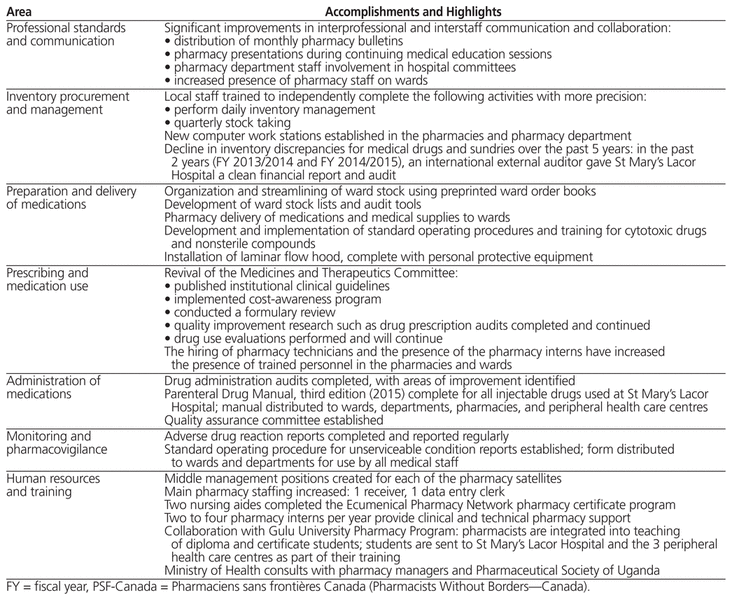
To aid in the sustainability of procedural interventions, standard operating procedures were developed for specific processes, such as ward inspections and completion of unserviceable condition reports. In addition to these documented standard operating procedures, the overall increased knowledge and experience of the current Lacor Hospital pharmacy and executive teams will aid in the continuity of interventions as well as the future improvement of procedures and education of staff. Significantly improved communication and collaboration with other health care professionals and administrative staff, through the distribution of monthly pharmacy bulletins, publication of the Parenteral Drug Manual, presentations during continuing education events, involvement in hospital committees, and increased presence on wards, will aid in sustaining clinical knowledge and continuity of a higher level of pharmacy care and support for patients.
A quantitative analysis of progress in relation to the 2008 Basel Statements at Lacor Hospital is summarized in Table 4. From 2009 to 2015, the number of fully achieved (status of “met”) statements climbed from 18 (24%) to 44 (59%). In addition, 14 statements achieved the status of “partially met”, increasing the success of the mission. The number of “not applicable” statements was reduced from 18 (24%) in 2009 to 13 (17%) in 2015. Seven of the 13 statements ranked “not applicable” revolved around human resources and training and thus required national-level collaboration. That level of collaboration was beyond reach for the hospital and for this particular PSF-Canada mission.
Table 4 Quantitative Analysis of Status of Pharmacy Practice in Relation to the 2008 Basel Consensus Statements at St Mary’s Lacor Hospital, Gulu, Uganda
The status of each PSF-Canada recommendation is detailed in Table 1. The original 24 PSF-Canada recommendations, which were the backbone of the PSF-Canada action plan, grew to a total of 34 recommendations, with the addition of 5 new recommendations following each of the 2011 and 2013 assessments (as described above). Twenty-three of these 34 PSF-Canada recommendations were completed over 5 years, with another 6 currently in progress.
This illustrative case study supports the use of the 2008 Basel Statements for baseline assessment, as well as implementation and follow-up of interventions to meet the preferred vision of practice for hospital pharmacy. The vision of the Basel Statements parallels the FIP mission to “improve global health by advancing pharmacy practice and science to enable better discovery, development, access to and safe use of appropriate, cost-effective, quality medicines worldwide.”3,13
Since their original dissemination in 2009, the Basel Statements have been utilized in both developed and developing countries to assess, advance, or implement hospital pharmacy practice.4–12 For example, shortly after circulation of the 2008 Basel Statements, the Paraguay–Uruguay project was developed to implement the Good Hospital Pharmacy Practice plan of these 2 countries using the Basel Statements and the FIP vision as core influences to develop their strategic goals.5 In the Western Pacific Region, Penm and others6,7 have completed projects focusing on pharmacists’ influence on prescribing and validating a hospital medicines formulary, using surveys to validate the achievement of specific sections of the Basel Statements. Pharmacists in China have changed their vision of pharmacy practice, moving from a focus on drug products to an emphasis on caring for patients, consistent with the vision that emerged from the 2008 Basel Statements.8 The European Association of Hospital Pharmacists used the Basel Statements when developing its statements on hospital pharmacy practice.10 Most recently, Lyons and others11 attempted to develop and pilot an assessment tool that institutions in a single country or across multiple countries can use to evaluate their pharmacies’ performance against the standards of the 2008 Basel Statements. In addition, the Basel Statements have been shown in both the United States and Canada to have a high degree of alignment with the standards of pharmacy practice of the American Society of Health-System Pharmacists and the Canadian Society of Hospital Pharmacists.12
The diversity in assessment and implementation techniques in different countries and regions demonstrates that medication safety requires commitment at the national, regional, hospital, pharmacy, pharmacist, and pharmacy technician levels. It also supports the FIP’s acknowledgement that it could not develop a simple “cook book” approach that could be applied in all settings.4 In September 2015, an updated version of the Basel Statements was launched, consisting of 65 statements.14 The revisions more closely align the statements with the WHO guidelines on good pharmacy practice and have a greater ability to account for the diversity of settings in which these statements may be implemented.2,14,15
This illustrative case study had 3 limitations. First, we were unable to assess the Lacor Hospital’s progress in relation to 13 of the Basel Statements (see Table 2). Eight of these 13 statements ranked as “not applicable” fall within the same theme, human resources and training. To achieve these criteria, a national-level assessment involving multiple stakeholders would be required, but such an assessment was not realistic for Lacor Hospital, nor was it within the scope of the PSF-Canada mission. The other 5 “not applicable” statements were related to areas that did not exist in or were not feasible for Lacor Hospital at the time, including enhanced pharmacy technology (e.g., unit-dose distribution systems) and investigational medications for research purposes. Second, use of the terms “partially met” and “in progress” to rank the status of the 2008 Basel Statements and the PSF-Canada recommendations, respectively, allowed inter-rater variability and subjectivity. In this case study, the assessors were the PSF-Canada mission leader and the on-site PSF-Canada pharmacist. The individuals holding these positions changed over time, which left room for different interpretations of the terminology at the time of assessment. Finally, the on-site PSF-Canada pharmacists were responsible for both the interventions to meet the prescribed goals and assessments of the outcome of these interventions, a situation that may introduce bias. Given the limited resources available for this PSF-Canada mission, seeking assessments from external or independent reviewers was not feasible. To overcome the potential bias, validation of the assessments was completed by many other key individuals, including past PSF-Canada pharmacists and St Mary’s Lacor Hospital staff members, such as the executive director, institutional director, medical director, senior administrators, matron, assistant matron, and internal auditors.
In addition to the first illustrative case study published by Poh and others1 in 2013, other publications have described the use of specific sections of the Basel Statements to influence areas of hospital pharmacy practice.4–12 However, to the authors’ knowledge, the current report is only the second descriptive study illustrating use of the majority of the 2008 Basel Statements as a framework to assess, realign, and monitor pharmacy practice in a tertiary care hospital. Given the recent updates to the Basel Statements, more documented use of the statements to assess and improve hospital pharmacy practice is required.
This case study illustrates use of the FIP’s 2008 Basel Statements to align a hospital’s goals for assessment, implementation, and improvement of hospital pharmacy practice. With the revisions to the Basel Statements that were released in 2015, more documented validation is required to verify the observations reported here. As recognized by the FIP, “It is important that we take these statements beyond our own profession and make other healthcare colleagues aware of our aspirations. Furthermore, our administrators and politicians know that we have these standards and that we need their support to promote and implement them in the interest of patients.”4
1 Poh J, Vaillancourt R, Lamarre D, Oyella J. Use of the 2008 Basel consensus statements to assess, realign, and monitor pharmacy practice at a tertiary care hospital in Northern Uganda: illustrative case study. Can J Hosp Pharm. 2013;66(5):318–27.

2 Annex 8: Joint FIP/WHO guidelines on good pharmacy practice: standards for quality of pharmacy services. In: Forty-fifth report of the WHO Expert Committee on specifications for pharmaceutical preparations. WHO Tech Rep Ser 961. Switzerland (Geneva): World Health Organization; 2011 [cited 2016 Feb]. pp. 310–23. Available from: http://apps.who.int/medicinedocs/documents/s18676en/s18676en.pdf
3 The Basel statements on the future of hospital pharmacy. Am J Heath Syst Pharm. 2009;66(5 Suppl 3):S61–6.
4 Gray A, Tredree R. Implementing the Basel statements on the future of hospital pharmacy: a global challenge. Int Pharm J. 2010;26(2):32–4.
5 Savio E, Fernández G, Omos V, Daners M, Gerpe N. FIP Basel statements and the future of hospital pharmacy services in Uruguay. Int Pharm J. 2010;26(2):39–41.
6 Penm J, Chaar B, Moles R. Validating a hospital medicines formulary survey in the Western Pacific Region—a global hospital pharmacy initiative based on the Basel Statements. Res Social Adm Pharm. 2012;8(4):298–308.
7 Penm J, Chaar B, Rose G, Moles R. Pharmacists’ influences on prescribing: validating a clinical pharmacy services survey in the Western Pacific Region. Res Social Adm Pharm. 2015;11(1):63–73.
8 DeChun J, YuQuin W, SuYing Y, XiaoLan L, Hong G, YaWei W. A comparison of Chinese hospital pharmacy practice and the Basel statements. Int Pharm J. 2010;26(2):42–4.
9 Zellmar WA, Hawkins B. The Basel statements as stimulus for advancement of hospital pharmacy in a developed country. Int Pharm J. 2010;26(2):44–6.
10 Vermeulen L. From Basel to Brussels: the FIP Basel Statements as the foundation of the EAHP Statements of Hospital Practice. Eur J Hosp Pharm. 2014;21(5):262–3.
11 Lyons K, Blalock SJ, Brock TP, Manasse HR Jr, Eckel SF. Development of a global hospital self-assessment tool and prioritization tier system based on FIP’s Basel Statements. Int J Pharm Pract. 2016;24(2):123–33.

12 Wright A, Vaillancourt R, Bussières JF, Lebel D, Wong E, Mancini D, et al. Best of both worlds: a comparison of Canadian and international best practices for hospital pharmacy services. Can J Hosp Pharm. 2015;68(1):48–53.

13 Who we are and what we do. The Hague (Netherlands): International Pharmaceutical Federation; [cited 2016 Feb]. Available from: www.fip.org/?page=menu_about
14 Revised FIP Basel Statements on the future of hospital pharmacy. The Hague (Netherlands): International Pharmaceutical Federation, Hospital Pharmacy Section; 2014 [cited 2016 Feb]. Available from: http://fip.org/files/fip/FIP_BASEL_STATEMENTS_ON_THE_FUTURE_OF_HOSPITAL_PHARMACY_2015.pdf
15 Thompson CA. FIP Hospital Pharmacy Section releases new version of Basel statements. Am J Health Syst Pharm. 2015;72(22):1924–5.

Lisa Brander, Nathalie Chenel, Elizabeth McMahon, Jennifer Wiebe, Allison Kirkwood, Ghada Shaka, and Doret Cheng volunteered their time and expertise while serving Pharmaciens sans frontières—Canada (PSF-Canada) as consultant pharmacists at St Mary’s Lacor Hospital in the Gulu District of Northern Uganda. ( Return to Text )
Funding: In addition to serving as volunteers, Lisa Brander, Elizabeth McMahon, and Ghada Shaka received wages from PSF-Canada while working on the Uganda mission. PSF-Canada is supported by the Teasdale-Corti Foundation and the Marcelle and Jean Coutu Foundation. ( Return to Text )
Competing interests: Other than wages listed above, no other competing interests were declared. ( Return to Text )
The authors would like to thank Caroline Potvin for serving as a leader and advisor for the Pharmaciens sans frontières—Canada mission in Uganda and Diane Lamarre for aiding in initial on-site assessment and in development of the original action plan.
Canadian Journal of Hospital Pharmacy, VOLUME 70, NUMBER 1, January-February 2017